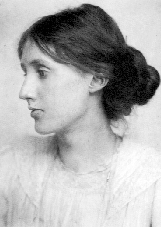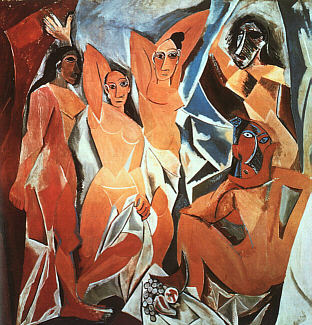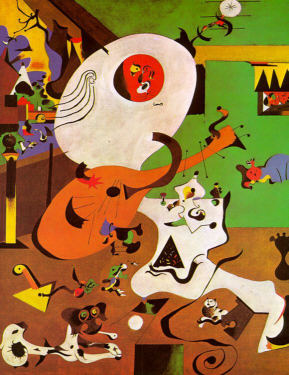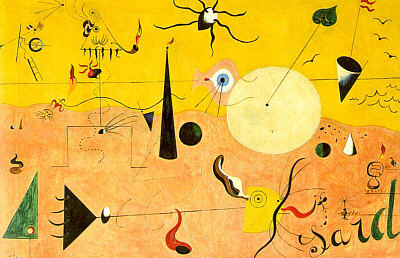Lecture XI.-- The Modern Novel: Virginia Woolf and the Word
Pablo Picasso La Vie (Life), 1903, oil on canvas, Cleveland Museum of Art. Graphic Reproductions of Spanish Cubists from CGFA Music: Mack the Knife from Midifarm
The Modern Novel--Virginia Woolf and
the Word
In the eleventh class session we will examine the roots of the modern
novel. At the dawn of the Twentieth Century, the sensibilities of the
past were discarded by many writers--and the change in attitude was also
reflected in novel form, language, and structure. Women, of course,
embraced the chance to upend traditional story patterns--eager for a
chance to create literature that was closer to their experience of life. While World War I. has faded in the common, popular consciousness to "just another war." In the historical chain of incessant wars, however, it was not viewed that way by the people of the time. The Great War was seen as a watershed, the end of an old, gracious, ordered, monarchical, patriarchic, familiar world. In its place, there quickly arose a world of the new, the savage, the disordered, the democratic and demagogic, dictatorial, formless, and unfamiliar world. Writers and artists quickly realized that the "old world" ideas were embedded in the old world practices, and they began searching for new methods to reflect the environment they inhabited. Cubism, surrealism, expressionism were all attempts of the plastic arts to respond to Twentieth Century conditions - and writers like Virginia Woolf were doing the same for literature.
Desiring truth, awaiting
The popular attention that has been directed to
Virginia Woolf seems to have consisted of two different brands. On
the one hand, there is the really romantic and daring "legend
material" of the Bloomsbury Group. In this scenario, Virginia
Woolf presides, in London, over the literati glitterati. Here we
have a select group of writers and artists who gather to talk esthetic notions and engage in sophisticated doings and undoings.
Essentially, this has been the version of Virginia Woolf that has
dominated popular culture. It arises out of our own Romantic Movement, the precepts of which we are fairly familiar, by now. 46 Gordon Square was where the Stephen sisters, Vanessa and Virginia, held court over Bloomsbury. The year was
1905. The idea of the select group of painters and artists had been a familiar one in the 19th Century, as well. We did not go into detail about the Pre-Raphaelite Brotherhood, among whom Christina Rosetti was a prominent member. But this notion of artists and writers somehow forming "groups" with "manifestos" was to become increasingly popular in the 20th Century. The Cubists were one such group, under the leadership of Pablo Picasso.
Pablo Picasso: Les Demoiselles d'Avignon, 1907, Giraudon, Paris. The Surrealists, often associated with Marcel Duchamp, was another. (In our presentation last week, we saw that Mary Hunter Austin wished to be admitted to one such group in California, but was rebuffed because she was not good-looking enough!) Why did this happen? In 1917, Leonard bought a printing press, partly to distract his wife from her "glooms," and set up the Hogarth Press
in the basement. Later, Hogarth Press was the first to publish Sigmund Freud in English (greatly inspiring Virginia).
They also published T.S.Eliot, Katherine Mansfield, Maxim Gorky and of course all of Virginia's writing-- with cover
art exclusively by her sister Vanessa. While the Bloomsbury Group itself was formed as early as 1905, and WW I. did not begin until 1914, there was a general sense, in Europe, that all was not well even during the very early years of the century. Movements like those in art - Cubism for example - carried a message that things were fragmenting. The notion that the safe, ordered Victorian world - a world of hierarchical order, paternalistic justice, and the idea of progress - was somehow fragmenting were present well before the war began. However, the advent of World War I, which was far more brutal and terrifying than any previous war, and the following in quick succession of the collapse of empires, cemented this notion in the popular mind. While movements for suffrage and rights continued, they did so against the backdrop of a persistent pessimism in western culture. While of course, not everyone was gloomy all of the time, even the good years were shadowed by the conviction that all of this was somehow aberrant, and that the world everyone knew was in grave danger of disappearing. In fact, it already had.
Miro - Dutch Interior "The compensation of growing old, Peter Walsh thought, coming out of Regent's Park, and holding his hat in his
hand, was simply this; that the passions remain as strong as ever, but one has gained--at last!--the power of taking
hold of experience, of turning it round, slowly, in the light." I begin with the information on the Bloomsbury Group, and Virginia as the key member, more as a move to get it out of the way than to stress its importance to the progress of Women in Literature - or women's writing. The other side of Virginia Woolf did not get much attention until the 1970's, when the Feminist Movement gathered strength. At that point, Woolf's "A Room of One's Own" became mandatory reading for all women writers, and critics began to look more closely into the deeper meanings of her work.
Miro - Catalan Landscape Imaginative work...is like a spider's web, attached ever so lightly perhaps, but still attached to life at all four corners....But when the web is pulled askew, hooked up at the edge, torn in the middle, one remembers We are reading A Room of One's Own. This essay is not, of course, the wonderful fiction for which Virginia Woolf is best remembered. However, it stands as an important document for us as we look at the history of women's writing. In a sense, Woolfe captures in this piece the things that women writers must have been thinking all along, but did not have the language or the illumination to express. It sets down, in much the same measured, careful way, the argument that literature does not simply arise from nothing - that it is the product, and influenced by, all of the environmental factors in an author's life. As we look further into the "Modern" writers - women about whom we know considerably more that we did about Aphra Behn, for example - we can begin to see the truth of this essay at many levels. From A Room of One's Own For it is a perennial puzzle why no woman wrote a word of that extraordinary literature when every
other man, it seemed, was capable of song or sonnet. What were the conditions in which women
lived, I asked myself; for fiction, imaginative work that is, is not dropped like a pebble upon the
ground, as science may be; fiction is like a spider's web, attached ever so lightly perhaps, but still
attached to life at all four corners. Often the attachment is scarcely perceptible; Shakespeare's
plays, for instance, seem to hang there complete by themselves. But when the web is pulled askew,
hooked up at the edge, torn in the middle, one remembers that these webs are not spun in midair by
incorporeal creatures, but are the work of suffering human beings, and are attached to grossly
material things, like health and money and the houses we live in.
Virginia's Last Note to Leonard Woolf TO: LEONARD WOOLF
Monday or Tuesday, A Collection of Virginia Woolf Short Stories. Cause for Fear: Sexual Apprehension in the Writings of Virginia Woolf by Lydia Tracy Pottle
|
|
Literature 45 - Women in Literature : Marjorie C. Luesebrink, MFA Contents: Announcements // Discussion Page // About Your Class // Class Syllabus // Lecture Notes // Discussion Group // Reading List // Recommended Reading // Assignments // Resources and Web Sites // Grading Policies // Contact Your Instructor
|






